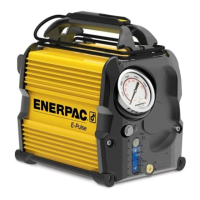18
11.0 CLEANING AND INSPECTION
• Periodically clean the cooling fins on the pump side surfaces
to remove any accumulated dust or dirt.
• Remove any dust or dirt from the pump front and rear covers
and the pump top and bottom surfaces. Be sure that all four air
vents are unobstructed.
• Periodically wipe the air breather/filter surface with a clean rag
to remove any loose dirt or oil sediment. The air breather/filter
must remain unobstructed to allow proper reservoir venting.
• Be sure that pendant and controls are free of dust or dirt.
• To prevent contamination, always remove any dirt from around
the oil drain/fill plug before removing it. Wipe the drain/fill plug
with a clean rag before reinstalling it.
• Check for loose, missing or damaged parts. Make repairs as
required before returning the pump to use.
12.0 STORAGE
Store the pump in a clean, dry and secure location.
To prevent possible damage to pump components, storage area
ambient temperature must not be less than -22°F [-30°C] and
must not exceed +149°F [+ 65°C].
13.0 TROUBLESHOOTING
The Troubleshooting Guide (Table 1) is intended as an aid to help
diagnose and correct various possible problems that may occur.
For repair service, contact your nearest Enerpac Authorized
Service Center. Only an Enerpac Authorized Service Center
should be permitted to service the pump and its components.
WARNING
Failure to observe and comply with the following precautions
could result in death or serious personal injury. Property
damage could also occur.
• Never tighten or loosen hydraulic fittings while the pump
hydraulic system or connected components are pressurized.
Escaping oil under pressure can penetrate the skin, causing
serious personal injury.
• Keep hands, fingers and other body parts clear of pinch
points and moving parts when observing operation during
troubleshooting.
• To prevent accidental start-up of pump during servicing, always
unplug the pump AC power cord from the electrical outlet
before performing any maintenance or repair procedures.
Table 1 - Troubleshooting Guide
Problem Possible Cause Action
1. Pump will not start. a. No power. Be sure that the pump AC power cord is
connected to the electrical outlet.
b. Pump fault triggered. Refer to Table 2, Pump Fault Codes, for
additional information.
2. Pump stops under load. a. Pump fault triggered. Refer to Table 2, Pump Fault Codes, for
additional information.
b. Pump bypass valve out of adjustment or
malfunctioning.
Contact Enerpac Authorized Service Center.
c. Pump jammed due to obstruction. Contact Enerpac Authorized Service Center.
d. Internal damage to pump and/or motor. Contact Enerpac Authorized Service Center.
3. Pump fails to build
pressure or builds less
than full pressure.
a. Control valve lever in “T” or “N” position. Move lever to “A” or “B” position.
b. Low oil level. Add oil to reservoir as required. Refer to
Section 10.3. Follow priming procedure in
Section 10.5 if pump reservoir was emptied
during operation or while pump was being
serviced.
c. Relief valve open or set too low. Raise relief valve pressure setting. Refer to
Section 9.0.
d. Oil needs changing. Completely drain and refill reservoir per
instructions in Section 10.4.
Use only Enerpac HF hydraulic oil.
Use of other oils may result in damage to
pump components and will void the Enerpac
product warranty.
e. External system leak. Repair or replace components as required.
f. Pump oil intake suction filter is dirty. Contact Enerpac Authorized Service Center.
g. Pump bypass valve out of adjustment or
malfunctioning.
Contact Enerpac Authorized Service Center.
(Continued on next page)

